In a separate post, I dissected Elizabeth Crowley’s ‘Light Rail to The Mall’ plan. Realizing this probably makes me look like a really mean spirited guy, allow me to put forth a far more superior plan.
Let’s call this the Ray Cev Plan. (I mean hey why not – it’s not like I’m being paid for this). It entails a phased rollout of new transit options across central Queens.
Phase One
Reopen the entire lower montauk to passenger rail service – LIC to Jamaica. (Not just to the mall, as per the Crowley idea)
Phase Two
A connection from the Lower Montauk tracks to the abandoned former LIRR rockaway Beach Branch, with a connection either directly to JFK or to the Air Train at Broad Channel.
Phase Three
Fixing connections around Rego Park and LIC to provide direct access to Manhattan.
Here’s a map showing phases one and two:
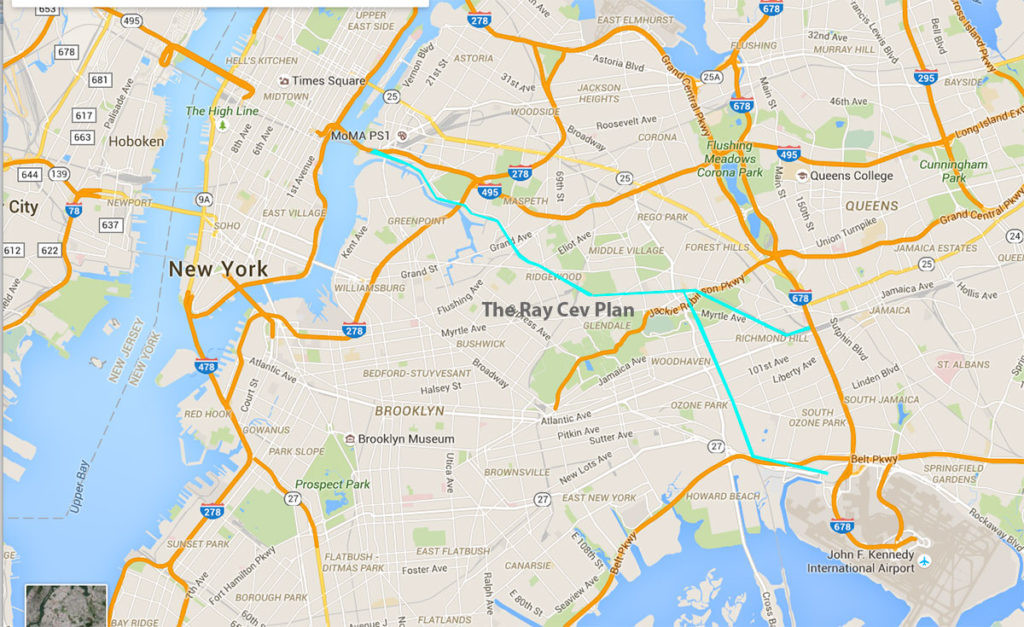
Before you say “there is no way that can be done’, read the details below.
Q: What costs are ‘Must haves”?
A: A signal system, stations, rail cars, some replacement freight yard track, and at least one bridge replacement.
Q: Where would stations be placed, how many would there be?
A: The communities can decide this. Let’s call it “Participatory Stationing“.
Just as the NYC City Council now has a ‘participatory budgeting‘ where communities get to vote on what to do with a small pot of cash allocated to each neighborhood, voters in neighborhoods along this route could vote on if they want a station, and where it would be located. If they want it, their taxes can fund it directly.
Each station would have to meet current federal ADA regulations. They should be ‘future proofed’ and constructed at least six passenger cars in length.
There can be a rule if needed: no stations within a half mile of each other (or some other measure…). Areas with higher population like Glendale and Ridgewood might want more than one stop, while some of the old LIRR stations that were on this route may no longer make sense (Pennybridge for example).
The goal here is to solicit the wisdom of actual commuters who would use these stations. We don’t want to just plop stations down where they might not be useful, nor do we want to cram something down the communities throats.
The only exception here might be Richmond Hill – where there is an existing station platform on a long viaduct that would be very expensive to modify. This station is placed near the current J subway line, as well as a commercial storefronts. It’s a rather ideal location already. No need to reinvent the wheel – let’s fix it up a bit and reopen it.
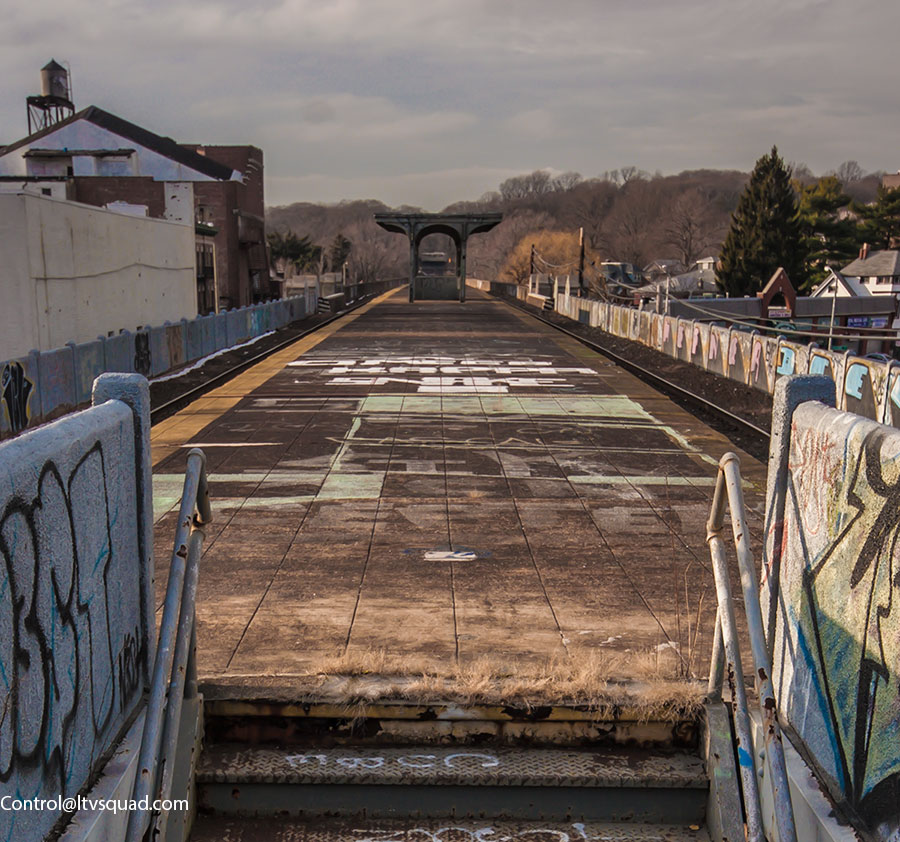
Existing Richmond Hill station (Abandoned)
Q: What kind of trains would this route feature?
A: FRA complaint ‘DMU’ Rail Cars
DMU cars could work well here. A ‘DMU’ car is a Diesel powered Multiple Unit car – units being actual train cars. Modern DMU cars are being build that meet EPA Tier 4 emission standards. Stringing overhead wires or adding a third rail would be extremely expensive and dangerous.
There’s a lot of pluses to be had by buying DMUs. Extra cars could be ordered for use on similar existing rail operations, like the ‘Greenport Scoot’ on the far east end of Long Island. The LIRR’s diesel haul fleet is stretched to capacity as it stands, so freeing up some cars would allow for better service on long island. By using compatible equipment on other MTA properties, we can also use existing repair shop and cleaning facilities at Hillside. The those repair facilities aren’t enough, there’s a new shop at Arch street in LIC, and land at the former Morris Park shop could be reused.
Q: How often could it run?
A: At the start of service, every 15-30 minutes, depending on time of day. Service could ramp up over time if needed. 6, 8 and 10 minute headways could happen as demand grows.
Q: What about all those freight trains?
A: They would have to run at night, though they cannot be eliminated.
Not every transit route in NYC needs to be a 24-7-365 operation, and we need to balance commuter needs with the need to transport food, construction supplies household waste, and other freight – all of which would affect consumer prices and increase taxes and pollution if moved to trucks (or in the case of waste, would necessitate landfills, right here in NYC). Much of the freight on this route also goes out to Long island, and all of it is federally protected interstate commerce.
Q: What about all the extra noise from all these trains ?
A: Again – participatory budgeting. How about installing noise barriers? Does the community want to spend money on these barriers?
Someone asked me “Why haven’t area elected officials already looked into noise barriers?” – I told her to talk to her elected officials and find out.
Neighboring home owners could just band together and build walls on their own property. If that sounds unsympathetic, such is life. The homeowners that bought real estate next to 125+ year old train tracks that were there before their houses were built have little right to expect no train noise. These are the same people who voted for Liz and Joe Crowley. If they don’t like their lack of leadership, they can take it up on election day. Meanwhile, the rest of us city residents can and will demand new transit options.
Maybe if they produced free green energy for the neighborhood they would be accepted?
This is all nice and dandy but what about…
Q: How much would stations cost:
A: The MTA previously estimated stations along this route would cost up to $2M. It’s mostly concrete, so that should be more than enough.
Q: Would there be a stop at the Mall?
A: Sure if the community wants it there, otherwise let the mall pay for it. Sorry, not sorry.
Q: How much would the actual DMU trains cost?
A: Maybe $100M, tops. A new transit agency in California recently signed a $56.9m contract for nine two-car diesel multiple-units to Sumitomo Corp and Nippon Sharyo. These cars have a seating capacity of 158 seats, plus 24 primary and 14 secondary bicycle spaces. That’s right: dedicated bicycle spaces – On a commuter train – in NYC. Think about that. In fact, contrast that with Crowley’s plan which is car-centric, using 1300 parking spots at the mall. Don’t we have enough car-reliance in central Queens?
That’s right: dedicated bicycle spaces – On a commuter train – in NYC
Q: How much is the signal system?
A: Someone should research that and comment below. I’m one guy writing a blog post. If this paid I’d dig up an estimate by looking at other recent transit projects, then tack on even more money for the federal government’s PTC requirements (for which the technology barely exists). I’m going to assume at least $50M.
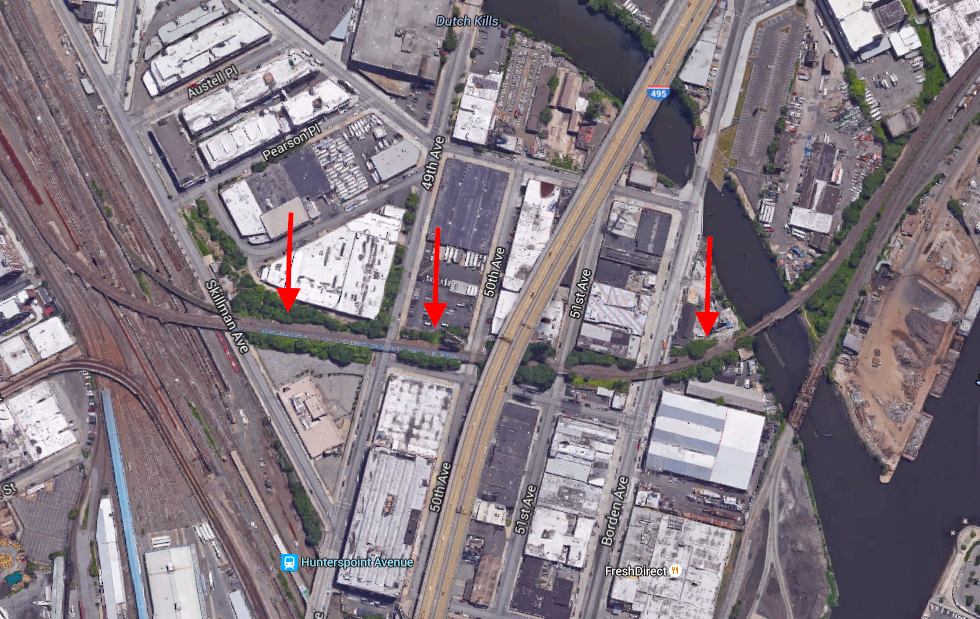
Q: What about the Montauk Cutoff and connection to Queens Plaza and Court Square?
A: That would require another bridge replacement, viaduct replacement, 2 more stations, legal wrangling over the route’s recent FRA abandonment and park conversion, plus major changes to existing LIRR ESA plans. This has expensive written all over it and would only serve to bog down the process of starting this service up. Maybe in the future, but not now.
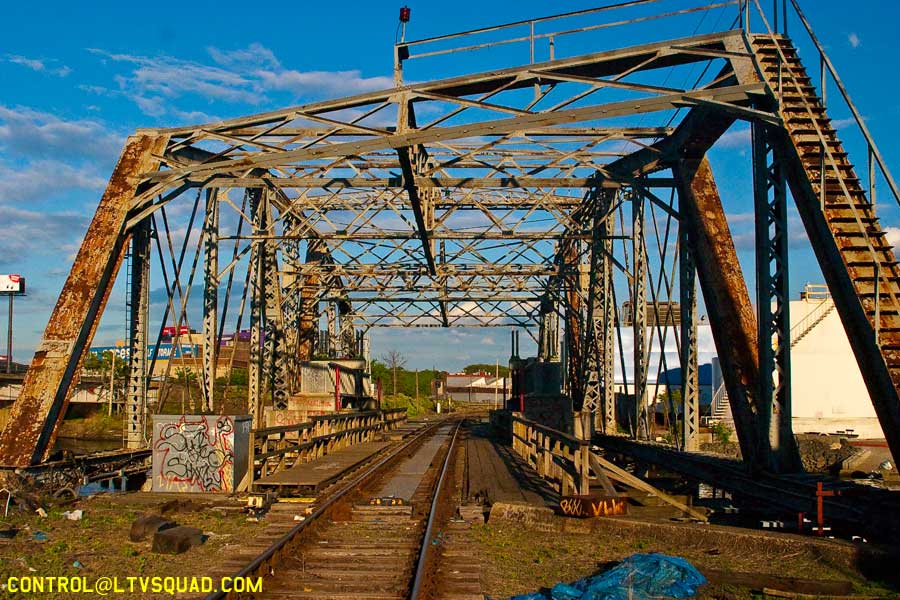
Q: How much to replace DB drawbridge?
A: I will guess at least $5-$50M. (It recently cost the city nearly $1M to rebuild a smaller bridge in Brooklyn, and nearly $150M for the Macombs dam bridge project – which is a much larger structure)
 Q: What about replacement freight track and double tracking?
Q: What about replacement freight track and double tracking?
A: This would be needed to make space at Blissville. It could be free (finding track elsewhere to park cars on), reduced (having Waste Management – the primary customer, and New York Atlantic Railway – the freight operator) pay for some of it, or around $250k-1M to lengthen some storage track at Blissville. On the higher end would be something like $50M-100M to buy up the property next to the tracks and expand the yard and maybe make storage space for extra passenger trains (separated from the freight storage – probably not needed, but…).
The startup costs for the first phase, from LIC to Jamaica, could be as low as $350 million.
The startup costs for the first phase, from LIC to Jamaica, could be as low as $350 million.
For reference, it cost a reported $2.4 billion dollars to build the recent 7 train extension (which may not included cost overruns due to significant delays).
Bloomberg came up with the money for the 7 extension entirely from the city budget. We wouldn’t need to sit around waiting for the state to do it (besides, they are so anti-NYC it probably wouldn’t happen if we counted on them).
Q: But who would use it?
A: Mostly central Queens residents living near the route, though tourists staying in hotels in LIC and Brooklyn might find this to be a quick way to get from the Air Train to Western Queens & Brooklyn. Also the bike racks on the trains would attract cyclists from say, Manhattan, LIC, Greenpoint and Williamsburg, to ride out to Forest Park, where there are numerous good trails for mountain biking. This route also might prove to reduce congestion along the Queens Blvd. subway routes. The connection to Jamaica and its Air Train would also be very appealing for those going to JFK, even if it means a transfer (because frankly, anything that doesn’t involve taking the subway or a cab on the Van Wyck is a huge improvement).
Back when LIRR was running passenger trains here, the commute time from Jamaica to LIC was less than 30 minutes. This route could save a lot of people a lot of time.
So what would be next?
After the first route is opened, it’s time to expand, to the benefit of everyone in the NYC area. We can connect the new LIC Jamaica route with a 2 mile reactivated segment of the Rockaway Beach Branch.
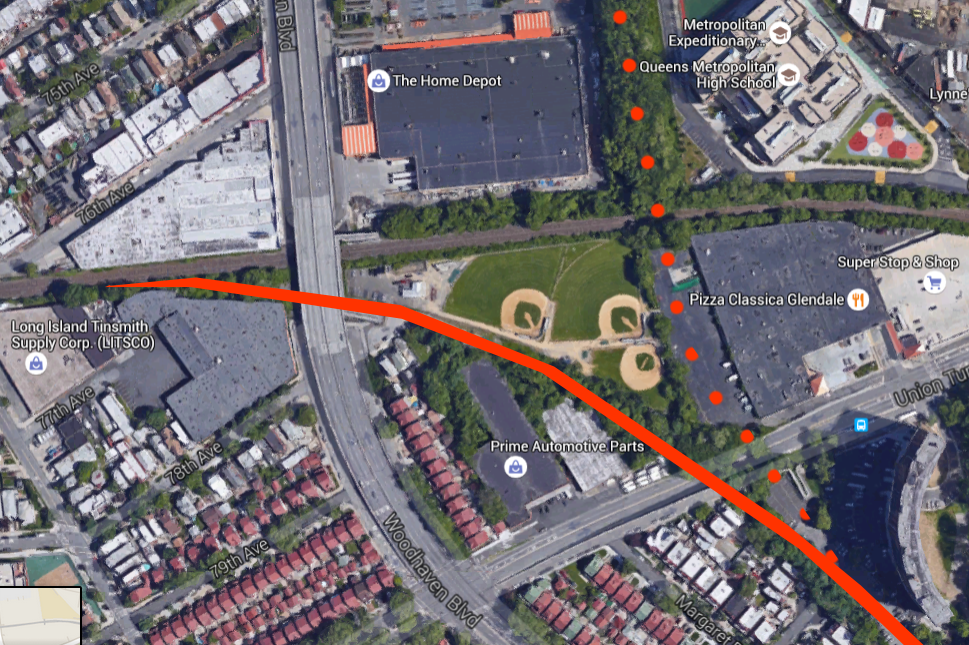
Glendale Junction – the lower montauk tracks (going across the middle) once connected to the Rockaway Beach Branch here (red dotted line). Note the tree lines and curved warehouse on the right where the tracks and freight sidings once existed.
Q: Why?
A: Because a 30 minute ride to JFK without making a transfer should be every New Yorker’s god given right.
Q: But what about the air train connection at Jamaica?
A: It’s slower to go out to Jamaica. You have to transfer, lugging your baggage around the station. And the communities along the Rockaway Beach route also need a transit line that will bring them closer to Manhattan, faster.
Q: Could the LIRR station at Atlantic Avenue & Woodhaven be reopened to create a transfer?
A: Yes. This would allow riders from downtown Brooklyn to also connect and get to JFK faster. You could even reconnect the Atlantic Avenue Branch to the Rockway Beach branch creating another one seat ride, though you need either third rail or a duel-mode train that can run off electric and diesel to do it.
Q: What would this entail??
A: The major costs here are clearing the 2 miles of embankment, stabilizing any washouts along the embankment, relaying tracks and signals. The overpass bridges all likely need complete replacements.
South of Lefferts blvd, modifications would need to be made to the existing A line subway tracks (which were once the LIRR Rockaway Beach Branch). The right of way here is already 4 tracks wide, so it’s possible to install two dedicated tracks for these new trains, separated from the subway tracks.
The terminal at Broad Channel would need some serious modifications. Alternately, a new route into JFK would also be costly.
But how much would Phase Two cost?
Given these variables, it’s impractical for me to put any sort of cost estimate on this extension of the route. I’m going to assume somewhere between 100-500M.
1) LIC and Downtown Brooklyn to JFK in 30 minutes.
2) Significantly reduced traffic through Queens. Clearing out the parking lot currently known as the Van Wyck Expressway.
3) Significantly improved air quality via drastically reduced inefficient taxi and bus trips between JFK and Manhattan.
4) The drastic reduction in taxi trips would result in less taxis (both yellow and Uber) across NYC – resulting in significantly less air pollution, less traffic, and less traffic related deaths.
That’s right: this plan can actually help save lives too. Let’s not forget overall better public health via significantly decreased airborne pollutants.
5) Reduced car dependency in central queens
With rail cars that are already designed with bike racks, residents of central queens would be far less dependent on cars for commuting. We’re taking even more cars off of the roads, and cleaning the air even further.
Anyone who has tried to reach JFK in recent years knows what a disaster this is. Either by car or (heaven forbid) subway, you’re in for a 2 hour ordeal. Our current Air Train goes nowhere and is dysfunction-ally useless unless *maybe* you live on Long Island and actually want to change trains in Jamaica.
Q: How many taxi and car trips are we talking about?
A: From JFK, around 10% of all arriving and departing passengers commute via taxi. Only 10-15% more arrive via Air Train. Assuming the city’s data is correct, that means 75% of airline passengers through JFK use either buses or private cars. In 2014, 53 million passengers flew through JFK. Even just removing a fraction of this traffic would take a huge amount of traffic off our highways and into more efficient, less polluting forms of transit.
Once service is up and running, with ridership growing year over year, there will be political will (and public demand) to complete the system. Complete it you ask? Yes.
The 7 Isn’t enough.
At the LIC end of the route, the 7 line isn’t enough to get more commuters to Manhattan.
There’s a few easy options:
1) A dedicated bus route running through a bus only lane in the Queens Midtown tunnel.
2) Increased Ferry service.
3) Cleaning up the nearby 21st Van Alst stop for commuters who might want to take the G (down to connections with the L, A, C and F lines).
4) Oh and those bike racks on the trains would prove really handy here. LIC is a far easier ride into Manhattan than riding from Glendale.
In the long term, another tunnel into Manhattan would be the best solution.
Q: What about the old Rego Park LIRR connection?
A: At the north end of the Rockaway Beach Branch, the tracks used to connect to the LIRR mainline. These tracks could be reconnected, potentially creating a one seat ride to Penn Station or Grand Central. All that would be needed is to clear out approximately 1 mile of overgrown rail embankment, and replacing overpasses.
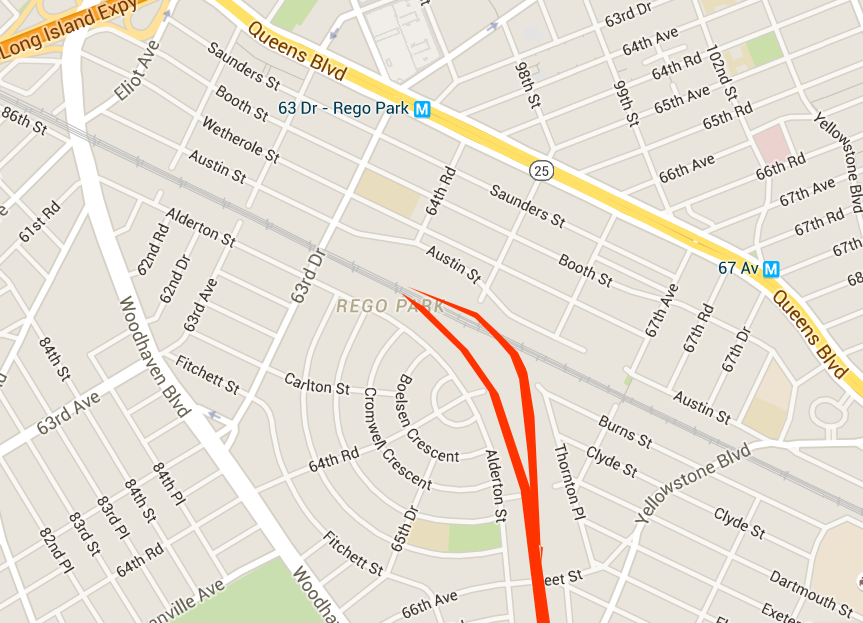
Map of the old Rockaway Beach connection to the LIRR main line at Whitepot Junction. Connecting to the subway up at Queens Blvd. would take some expensive tunneling work, while reconnecting to the LIRR mainline is just a matter of laying track, signal and switches.
Q: But what about connecting to Queens Blvd subway?
A: Yes, there were small provisions built on the Queens blvd subway route to connect it to the rockaway beach branch, but the two routes are 4 blocks apart. You’d need to build some very expensive tunnel and likely eminent domain some buildings to do it, displacing residents.
Is it doable? Yes. Is there any political will to do it right now? Not now, but perhaps in the future, when there is a far better documented need for better connections. Remember: There are still a lot of fools looking at the old LIRR ridership numbers saying “we don’t need any of this”.
How do we build the case to reconnect the northern end of the Rockaway Beach Branch and provide one seat rides from Penn Station and Grand Central Terminal, or connecting it to the Queens blvd. subway? By building the low hanging fruit – the LIC to Jamaica and JFK routes. It’s simple, it’s relatively cheap, and as ridership grows, the need will be all the more clear to our do-nothing elected officials.
Q: But what about Queensway?
A: For those that don’t know, Queensway is a park that our derpy governor is funding – it would take over the Rockaway Beach tracks, thus eliminating any possibility of ever running trains on it again.
Q: Why does Cuomo hate Queens Commuters so much?
A: You should ask him directly. Queensway is a stupid, shortsighted idea. NYC, and Queens, need better transit options.
I am a realist. I know the chances of any of this happening ever are unlikely. They are especially unlikely because our political ‘leadership’ is either actively working to destroy this route (Cuomo, via Queensway), doesn’t have a real plan (Elizabeth Crowley), or lives in Virgina and doesn’t care (Congressman Joe Crowley).
When you compare this plan to the developer driven “Light Rail to The Mall” plan, it should be crystal clear that a plan based off actual commuter needs is far, far better than an idea being pressed by city councilwoman acting as a developer’s proxy to increase the value of their real estate holdings.
A project like this couldn’t be built overnight, but the first phase could easily happen within the next 2-5 years if it were seriously undertaken with strong leadership to control costs. This would built momentum and show the type of progress that would garner significant community support across the entire city.
In a follow up post I’ll build on this model even further.
Update: May 2016. The montauk cutoff was officially abandoned by the FRA and the MTA is actively looking to lease the property to a community organization. No trains will run on these trains anytime soon – and again, not without costly bridge replacements.
The hiking trails in Forest Park have no biking signs. I’ve used them at dawn before without issue, but I don’t know how well it would be tolerated if a lot of people started doing the same. If anyone goes, watch out for hikers, joggers, and the off leash dogs, especially before 9am. On the horse paths you’d probably have fewer conflicts.
Another option is to have the DMU’s powered by LNG/CNG to better comply with any future stringent air regs. If fleets of busses powered by CNG can improve air quality, especially particulate matter then NG vehicles are a no brainer since NYCDEP is looking for a use for its generation of methane at their WWTPs.
So you have decreed that freight does not have to operate days or evenings here. Glad that’s settled!
Rob – not exactly. There’s a trash shuttle train in Blissville that cannot only run at night (I would suggest reading the other post about the constraints inherit at Blissville these days). The City has a 20 year agreement with Waste Management to handle trash this way, and unless every person in this city is going to stop creating trash, the trash train is the cheapest, most ecologically sound method of moving it out of the city at the moment. Shutting that operation down = much higher taxes for everyone in the city, plus hundreds of more trucks on our roads. It’s just not viable.
There’s plenty of places where freight and passenger rail co-exist, even during daytime hours. Both CSX and New York Atlantic run during the day on Metro North and LIRR. The key here is that these tracks will never host subway style equipment, or the Jersey City style light rail that Crowley seems interested in. The dreamers out there need to face this reality.
We need to organize, educate and motivate the commuter to expand railways in the outer boroughs. We need more faster and safer transportation options that will help all commuters. Join the Queens Public Transit Committee. http://www.qptc.org, 718-679-5309, PhilAMcManus@gmail.com
The Denton County Stadler cars are cleared for running intermixed with freight. Unfortunately the Union Pearson Express cars have serious problems and Sonoma Marin which is also getting these cars will be delaying startup due to those problems.
Hi Ray,
Great stuff.
If you are still doing this please contact me at your earliest convenience to compare notes. We’re starting to make some progress.